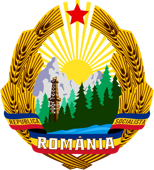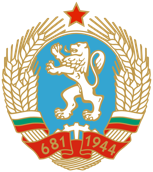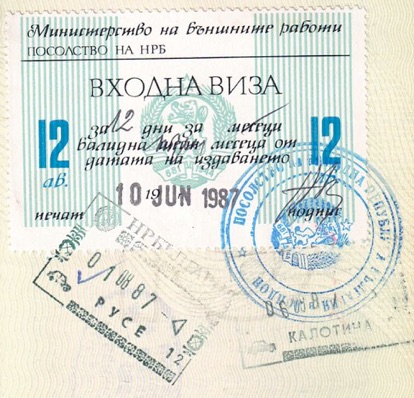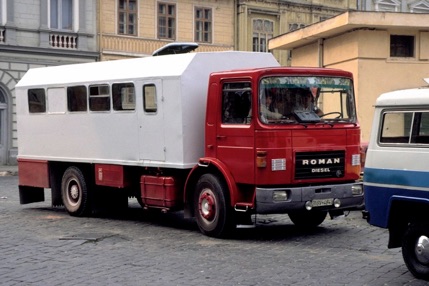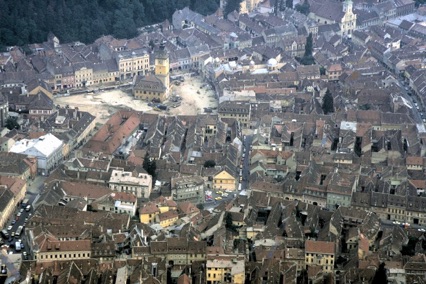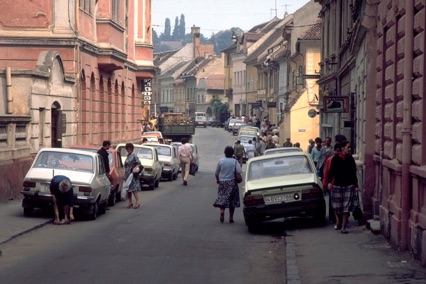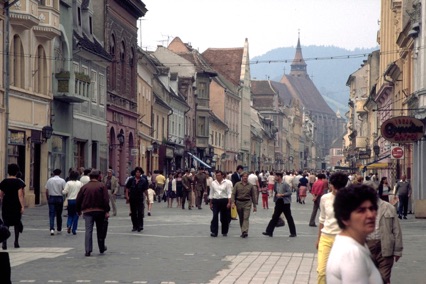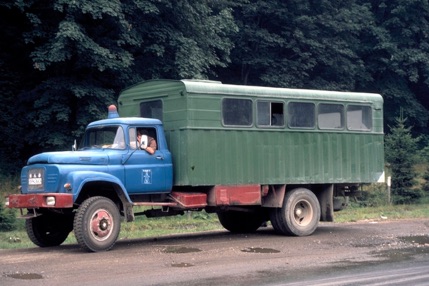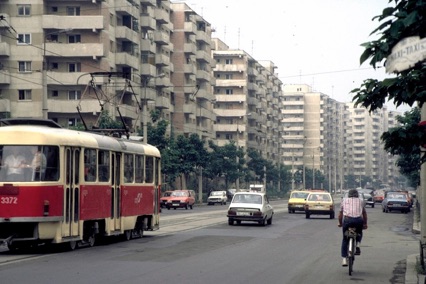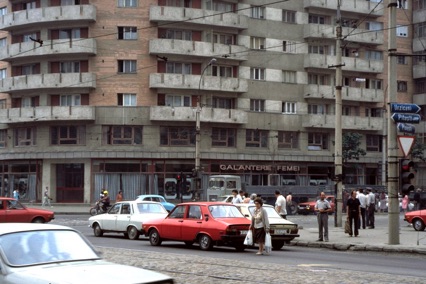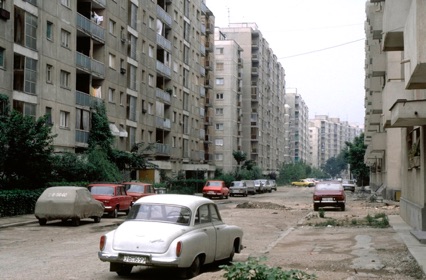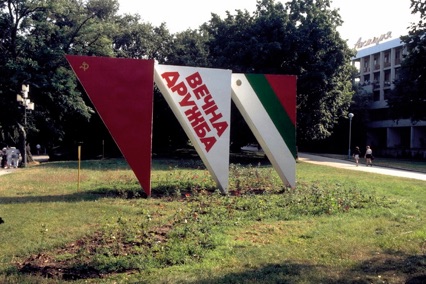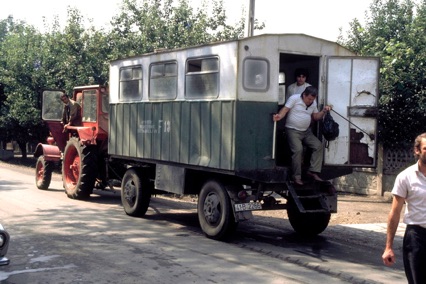Europe 1987

Kyrgyzstan and Tajikistan 2018

None of us slept very well last night. Tim was restless for much of the night, and we all woke at about 6:30am. We went to the hotel’s dining area for breakfast at 7:30am, which was omelette and inedibly dry bread rolls that were useless for all of us except Tim who enjoyed playing with them by crumbling and spreading them across the floor.
Following breakfast, we went for another walk through the old town near the hotel, making our way through the beautiful Piaƫa Sfatului (which was under extensive renovation, being re-paved) to the historic Black Church, built between 1384 and 1477. From there it was just a short walk to the Telecabina Tâmpa cable car station, which rises from 640m to 960m to give superb views across the old town. More accurately, the views are apparently beautiful on a clear day, but we were somewhat underwhelmed by the experience. There was nowhere to see the city from the summit at Mount Tâmpa. Furthermore, the views from the cable car on ascent and descent were partly obscured by a combination of misty air, dirty windows and the thick cables that were performing the important task of carrying our gondola.
Returning to the hotel, we spend some time writing postcards, and using up our remaining “non-petrol” coupons by buying some drinks. I had heard the expression “flavour of the month” many times before, but in Romania we found that it’s literally true. Up until last night, the only soft drink available was cherry-cola, but overnight all the stocks of that flavour had disappeared and every shop and street stall had started selling August’s new flavour – citron (a lemon flavour). And the good news is that Phillip would drink it (after having all the bubbles blown away first, of course). Di and I were very grateful we had been here on the change of the month, because we believe the new flavour prevented our little boy succumbing to severe dehydration.
Around mid-morning we set off for the drive south towards Bulgaria via Bucharest, Romania’s capital city. The scenery on this drive was often pretty but spoilt by an impressive number (in one sense) of smoke-spewing factories. We drove into the metropolitan area of Bucharest along Highway 1 and headed for the Arch of Triumph (Arcul de Triumf), closely modelled on the Arc de Triomphe in Paris. Of course, it was not possible to stop or park nearby, so we turned towards the right and headed south-west along Strada Turda, stopping about a kilometre further on near the corner of Bulevardul Ion Mihalache to have our small lunch that we had brought with us. This gave me a rare chance to sneak some photos of Bucharest, avoiding the sinister looking police officers that seemed to be standing on nearly every corner, along both main roads and even along a nearby smaller street in a terrible state of disrepair, Strada Cluj.
Having had lunch and sneaked some photos, we continued our drive, choosing to skirt the main city centre because the traffic looked very heavy, which posed a risk of arriving too late at our destination across the border.
We continued south along Highway 5, making just one more stop at a small farming town on the flat plain 17 kilometres south of Bucharest called 30 Decembrie (meaning 30th December, named after the date in 1947 when the Romanian monarchy was overthrown and Romania become a republic – interestingly in 1996, the town was re-named 1 Decembrie after the date in 1918 when the Kingdom of Romania was united with Transylvania). The reason we stopped was to photograph a typical tractor-drawn trailer-bus and a few representative examples of the typical propaganda signs we had seen so often during our drive through Romania. The translation of the two signs posted on this page are:
-
Our esteem and passion – Ceauşescu Romania! (Header photo)
-
“In our country, agriculture is a basic branch of the socialist economy; it is clear that without an intensive, modern high-productivity agriculture, organised on the basis of the latest conquests of science, neither the creation of a multilaterally developed socialist society nor the building of communism in our homeland can be ensured”. Nicolae Ceauşescu (Photo at the foot of the page)
As we continued driving south I became increasingly worried that we might run out of petrol before reaching the border, because every one of the petrol stations with a pump for foreigners was closed as we drove up to it. Fortunately, the land was flat so I could drive steadily and economically, but the drive was more than a little tense as I kept doing mental calculations of fuel use and remaining distance to travel.
We reached the border at Giurgiu at about 5:00pm, exited Romania, and drove across the Danube River bridge to the Bulgarian immigration post to enter Bulgaria in the port city of Ruse. Fortunately, the immigration processes on both sides of the Danube were hassle-free.
To my delight, with the fuel indicator on “empty”, I saw a petrol station and drove straight in to fill the car with fuel. I needed to change money and purchase fuel coupons first of course, which I did in the office attached to the petrol station, and then I filled the tank. That was when I learned how generous some Bulgarian people can be. The lady attending the pumps refused to accept my fuel coupons despite my persistent protestations – I still have no idea why. She just kept ushering me to leave the petrol station without paying; it remains a mystery for us to this day.
I could never have imagined how liberating entering Bulgaria would feel after the experience of Romania. Everything was more relaxed, and as a driver, this included driving on much better maintained roads. The mix of cars on the road was another instant change upon crossing the border. The overwhelming dominance of Dacia 1300s suddenly evaporated, and we had a much broader mix of Soviet and Eastern European makes. That was good for one of our daily “Spotto” games with the children, which was “who can be the first to spot a Wartburg Tourist today”? Wartburg Tourists were the station wagon version of the boxy Wartburg 353 sedan, an East German vehicle powered by a two-stroke engine with only seven moving parts. For some inexplicable reason, the name “Wartburg Tourist” had tickled our fancy and caused mild amusement.
We continued our drive towards the south-east to the Black Sea city of Varna, passing through some torrential rain at one stage. Like Czechoslovakia and Romania, Youth Hostels have no relationship with accommodation places in Bulgaria, but unlike those two countries, it is not possible to make any accommodation bookings ahead of time. Moreover, only same-day reservations were possible, and for one night at a time; it was not even possible to book accommodation for the following day. I think it was something to do with the way group tourism was arranged and controlled by the monopolistic government tourism authority. Nonetheless, we had been assured before we left the UK that the Black Sea resorts always have plenty of accommodation, so it would not be a problem for us.
Those assurances soon proved to be wrong. Being the regional centre of Black Sea towns, all accommodation for foreigners must be arranged in person at the tourism office in Varna, or in one of their subordinate delegated offices. We reached Varna at 9:00pm and went straight to the tourism office. After standing in a long line for a long time, I finally reached the counter to be informed that there was no accommodation left for that night – not anywhere on the Black Sea coast. I explained I was travelling with my wife and three young children, and asked what I should do. The reply was to drive further north to Albena, which has a separate tourism office.
The drive to Albena took about 45 minutes, and although it was very late by the time we arrived, the small travel office at Albena was still open, not that it mattered because there was no accommodation there either. It was very late, but we really had no choice; we had a very late dinner and settled down for the night to sleep in the car. Although Di and I were very relieved that Citroën front seats recline, sleeping in the car on a grassy patch behind sand dunes with three children in the back is what I would call – sub-optimal.

Day 20
Braşov to Albena
Saturday 1 August 1987
